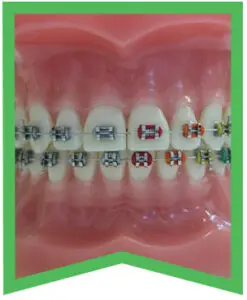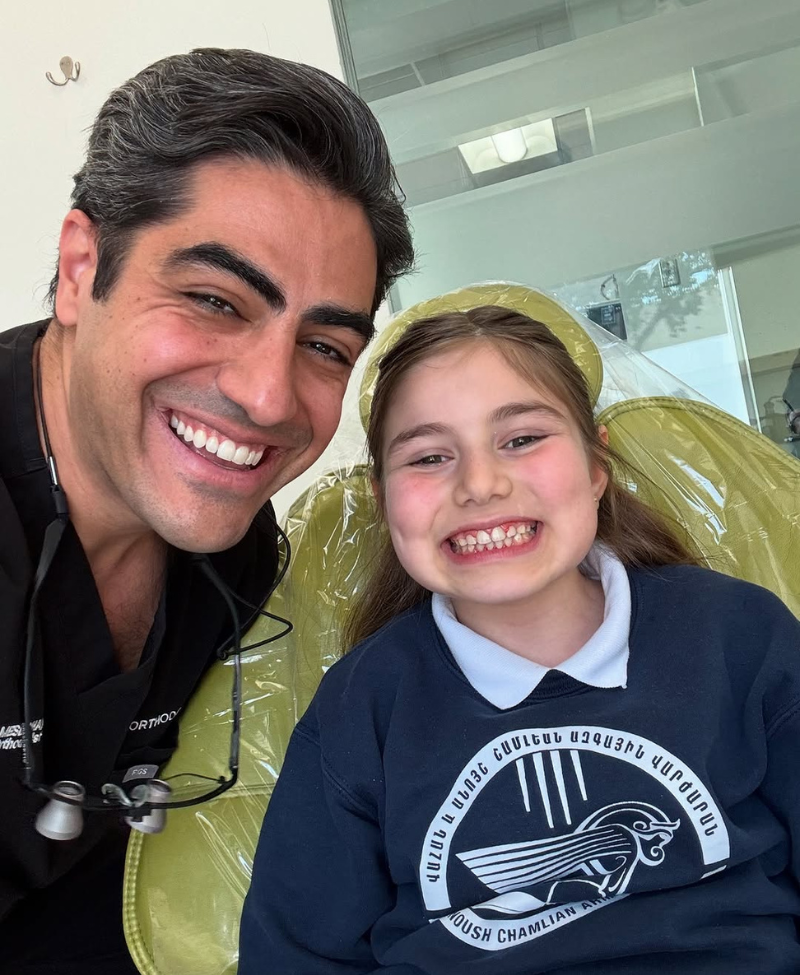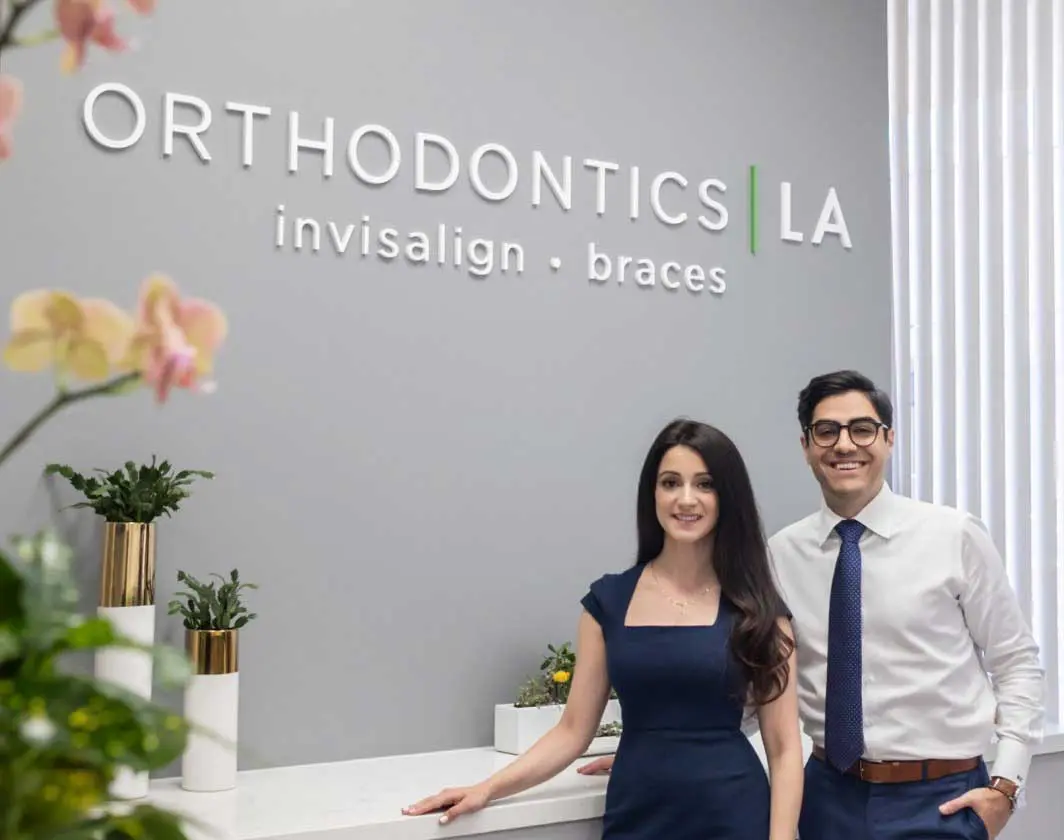Smaller Brackets. Faster Results.
These Aren’t Your Mother’s Braces.
Traditional Braces in Encino & Glendale
How do braces work?
The most common type of braces are traditional braces. Made of high-grade stainless steel, metal braces straighten your teeth using metal brackets and archwires. Once the metal brackets are glued onto your teeth, a metal wire is inserted that will be held by the brackets. During each appointment, your braces will be tightened to further align your teeth. With metal braces, you have the option of adding colored elastics (rubber bands) for a more unique and colorful smile.
How long do you have to wear braces?
Every case is unique. Some people may wear braces for only 6 months while others may need them for over 2 years. Typically, traditional braces will need to be worn between 18 months and 2 years. A few factors that may contribute to wearing braces for a longer period of time include dental conditions such as malocclusion, gaps, and overlapping teeth. The entire process can take longer if a patient must go through the two-phase treatment to correct issues of crowding or removal of teeth.
Are braces painful?
For the most part, braces shouldn’t be painful. When most patients get their braces affixed for the first time, they may feel some soreness from the pressure being placed on the teeth. This discomfort typically only lasts for 1-2 days until the teeth adjust to their new position. The metal brackets and wires are also known to cause mild discomfort if they poke into the mouth. Patients can use wax to keep sharp objects from protruding into their mouths. If there is severe pain, see an orthodontist immediately. Braces are meant to help you, not hurt you!
What age do people get braces?
Adolescents and teenagers between the ages 12 and 18 are popular recipients of the treatment because their adult teeth are still developing and easier to mold into shape. However, anyone can get braces! Braces can improve your confidence and dental health. They can align the teeth to prevent teeth grinding and allow people to clean their teeth better. It’s completely normal to get adult orthodontics and it can even be beneficial for people to wait until after they remove their wisdom teeth.
Can I eat normally with braces?
Braces are meant to add little to no obstruction to your everyday life, but keeping that in mind, there are foods that should be avoided to produce the best results. Overly acidic foods should not be eaten to prevent the corrosion of glue that holds the metal brackets to your teeth. Sticky and crunchy foods such as caramel and apples should also be eaten sparingly due to the issue of cleaning each individual bracket.
Are braces covered by my insurance?
When you come in for your complimentary consultation, we can verify if your insurance covers the cost of your procedure. If you would like to make sure, please contact your provider to see what amount of costs will be covered.
At Orthodontics LA, our orthodontists will create a custom treatment plan, so you can achieve the beautiful results you want. We have orthodontic offices in Encino and Glendale, so stop by for a free consultation today!
Early Treatment
Braces for Kids
Early treatment is when a younger patient, typically a child around 6 – 8, receives an orthodontic screening to check how their teeth and bones are developing. Orthodontists like to see patients in this age range because at this point, enough permanent teeth have grown in to determine whether or not a child will need orthodontic work. If the orthodontist sees there is an abnormal or misaligned structure in the mouth, preventative measures can be taken to correct it.
Interceptive orthodontic work ensures the teeth and jaw develop properly as the child grows and permanent teeth come in. Though it is not a necessary procedure for every child, our orthodontists can tell you if your child needs early treatment if your family dentist recommends a screening. It is important to evaluate developing teeth because, from that point, orthodontists can monitor a child’s growth.
Candidates for early orthodontic treatment are children who exhibit:
- Bruxism or grinding of teeth
- Underbite/overbite
- Excessively spaced teeth
- Extra teeth
- Thumb sucking
- Early loss of baby teeth
- Difficulty biting properly
- Malocclusion
There are many different kinds of early orthodontic treatment that can be prescribed, besides braces, for kids in Glendale and Encino. There are devices that assist the movement of teeth, change jaw positioning, and to hold teeth in place while waiting for other areas of movement. Other forms of treatment may involve removing baby teeth to help permanent teeth erupt with more space.
Some orthodontic problems may be easier to correct if they are found and treated early and can prevent larger costs in the future. Important problems to observe from age 6-8 consist of crowded teeth, abnormal eruption, and crossbites. Waiting until all permanent teeth have come in, or until facial growth is nearly complete, may make correction of some problems more difficult and costly.
Our orthodontists can determine whether or not an early orthodontic treatment is necessary. For some cases, early orthodontic treatment can adjust the bite better than adult orthodontics because the teeth are still developing and easier to move. Ask Dr. Artin and Dr. Mel from Orthodontics LA for an early orthodontic treatment screening.
Two-Phase Treatment In Encino & Glendale
Two-phase treatment is a method of realigning teeth with braces that requires two separate phases. Each phase focuses on a different goal. The purpose behind the two-phase treatment is to combine both tooth straightening and the realignment of facial skeletal structure. This treatment is meant to create an aesthetic result that lasts a lifetime.
Phase 1
The first phase is about aligning the skeletal or orofacial structure before the permanent teeth grow in. The orthodontist will take x-rays and photos of the teeth and jaw to determine whether this early orthodontic treatment is necessary. If the jaw or bite is incorrectly aligned, this may lead to more serious issues later on that are difficult and costly to correct. Treating these problems when the teeth are still developing is much easier than trying to correct issues later in adulthood. Baby teeth may be extracted to make room for adult teeth to grow in properly and prevent overcrowding or a retainer may be used to straighten out the bite.
Resting Period
During the resting period, the permanent teeth are left untouched to allow them to grow in. It is best to avoid orthodontic treatment during this period to avoid interference with permanent teeth and to allow them to move freely. The first phase should have helped to create a path for permanent teeth to begin orthodontic work.
The resting period usually lasts around six months and it is important to monitor the movement of teeth to determine further steps for the patient. From here, the patient will move on to phase two where braces are typically introduced.
Phase 2
The second phase focuses on correcting the teeth for a straighter smile. The purpose behind this phase is to ensure that each tooth has a designated location in the mouth and that it blends in with facial features. The phase begins once all permanent teeth are grown in, with the braces usually lasting for an average of 24 months. Phase two is typically when a full set of upper and lower braces are introduced. To ensure long-lasting results, retainers are worn to prevent the movement of teeth.
Whether or not two-phase treatment is necessary will depend on each patient’s situation, but it may require a longer process than traditional braces. The time between each phase is also contingent on every unique circumstance.
Let our Encino & Glendale orthodontists know if you think you need two-phase treatment for yourself or your child and they can help assess whether it would be beneficial.





